Timolol Eye Drops 0.5%

Timolol 2.5 mg/ml (as timolol maleate 3.4mg/ml)
Timolol 5.0 mg/ml (as timolol maleate 6.8mg/ml)
Please read this leaflet carefully before you start to take your medicine.
Keep this leaflet. You may need to read it again. If you have any further questions, please ask your doctor or pharmacist. This medicine has been prescribed for you. Do not pass it on to others. It may harm them, even iftheirsymptomsarethe same as yours. If any of the side effects gets serious, or if you notice any side effects not listed in this leaflet, please tell your doctor or pharmacist.
This medicine will be called Timolol in this leaflet.
In this leaflet:
1. What Timolol is and what is it used for
2. Before you use Timolol
3. Howto use Timolol
4. Possible side effects
5. How to store Timolol
6. Further information
1. WHAT TIMOLOL IS AND WHAT IS IT USED FOR
The active ingredient timolol belongs to a group of medicines called beta-blockers.
Timolol is used to treat raised pressure of eye (intraocular pressure) which occurs in various conditions including glaucoma and ocular hypertension.
2. BEFORE YOU USE TIMOLOL Do not use if you:
e are allergic (hypersensitive) to timolol maleate or beta-blockers or to any other ingredient of this medicine (see section 6 for more details) e if you have now or have had in past respiratory problems such as asthma, severe chronic obstructive bronchitis (severe lung disease which may cause wheeziness, difficulty in breathing and/or long-standing cough).
• if you have a slow heart beat, heart failure or disorders of heart rhythm (irregular heart beats)
Take special care with Timolol
Before you use Timolol please tell your doctor if you have now or have had in the past:
e coronary heart disease (symptoms can include chest pain or tightness, breathlessness or choking), heart failure, low blood pressure e breathing problems, asthma or chronic obstructive pulmonary disease e poor blood circulation disease (such as Raynaud's disease or Raynaud's syndrome) e diabetes as timolol may mask signs and symptoms of low blood sugar e overactivity of the thyroid gland as timolol may mask signs and symptoms Tell your doctor before you have an operation that you are using timolol as it may change effects of some medicines used during anaesthesia.
Paediatric population:
Timolol eye drop solution should generally be used with caution in young patients. In newborns, infants and younger children Timolol should be used with extreme caution. If coughing, wheezing, abnormal breathing or abnormal pauses in breathing (apnoea) occur, the use of the medication should be stopped immediately. Contact your doctor as soon as possible. A portable apnoea monitor may also be helpful.
Timolol has been studied in infants and children aged 12 days to 5 years, who have raised pressure in the eye(s) or have been diagnosed with glaucoma. For more information, talk to your doctor.
Using other medicines
Timolol can affect or be affected by other medicines you are using, including other eye drops for the treatment of glaucoma. Tell your doctor if you are using or intend to use medicines to lower blood pressure, heart medicine or medicines to treat diabetes. Please tell your doctor or pharmacist if you are taking or have recently taken any other medicines, including medicines obtained without a prescription. In particular:
• a calcium antagonist (e.g. verapamil or diltiazem) often used to treat high blood pressure, angina, or an abnormal heartbeat
• digoxin, often used to treat heart failure or an abnormal heartbeat
• medicines known as a catecholamine-depleting agents (e.g. rauwolfia alkaloids/reserpine) used to treat high blood pressure
• a pressoramine (e.g. adrenaline) used to treat severe allergic reaction
• clonidine to treat high blood pressure
• quinidine, a medicine used to treat heart conditions and some types of malaria
• other beta-blockers (e.g. other preparations of timolol both oral and/or ocular), which belong to the same group of medicines
• antidepressants known as fluoxetine and paroxetine.
Pregnancy and breast-feeding
Do not use Timolol if you are pregnant unless your doctor considers it necessary.
Do not use Timolol if you are breast-feeding. Timolol may get into your milk.
Ask your doctorfor advice before taking any medicine during breast-feeding.
Driving and using machines
No effects on ability to drive and use machines have been reported. However do not drive or operate machines if you experience any visual disturbance after using the product. Wait until this clears before driving or using machines.
Important information about some of the ingredients of Timolol Eye Drops:
The eye drops contain benzalkonium chloride as preservative which may cause eye irritation. Avoid contact with soft contact lenses. Remove contact lenses before using the eye drops and wait at least 15 minutes before reinserting. The preservative is known to discolour soft contact lenses.
3. HOWTO USE TIMOLOL
Always use Timolol exactly as your doctor has told you. You should check with your doctor or pharmacist if you are not sure.
The usual starting dose is one drop of 0.25% eye drops into each affected eye(s) twice daily, approximately 12 hours apart. Your doctor will change your treatment as necessary. If you are using in combination with another eye drop medicine, wait 5-15 minutes before applying the second eye drop.
Posoloov:
Paediatric population:
A detailed medical examination should precede the use of Timolol. Your doctor will carefully evaluate the risks and benefits when considering treatment with Timolol. If the benefits outweigh the risks, it is recommended to use the lowest active agent concentration available once daily. With regard to “the use in children", the 0, 1 % active agent concentration may be sufficient to control pressure within the eye. If the pressure is not sufficiently controlled with this dosage, a twice daily application at 12-hourly intervals may be necessary. Patients, especially newborn, should be closely observed for one to two hours after the first dose and careful monitoring for adverse events should be carried out until surgery is performed.
Instructions for use:
(please also refer to pictograms at the end of the leaflet)
• First wash your hands
• Avoid touching the eye (or any other surface) with the tip of the bottle
• If you wear soft contact lenses, they should be removed before using the eye drops and wait at least 15 minutes before reinserting
• These drops are supplied in a low density polyethylene (LDPE) bottle with LDPE dropper nozzle, white coloured HDPE screw cap and tamper-evident LDPE dust cover. When using the bottle for the first time, snap off the dust cover by turning it clockwise to break the seal. Unscrew the inner cap.
• Tilt your head back and look at the ceiling
• Pull the lower eyelid gently downwards
• Hold the bottle upside down above the eye and gently squeeze the bottle to release a drop into your eye
• After using Timolol, press a finger into the comer of your eye, by the nose for 3-5 minutes. This helps to stop timolol getting into the rest of the body.
• Repeat for the other eye if necessary
• Replace and tighten the cap immediately after use.
Duration of treatment:
Fora transient treatment in the paediatric population.
Be careful not to touch the tip of the bottle on your eye or on any other surface.
Ocular solutions if handled wrongly can become contaminated by common bacteria and cause eye infections. If you do develop any other eye condition whilst using this product, see your doctor immediately.
Keep using your medicine until yourdoctor tells you to stop.
If you use more Timolol than you should
If you accidentally use too much, contact your doctor or go to the nearest hospital casualty department immediately.
Overdose:
There is no experience of an overdosage with Timolol which is unlikely when given as eye drops. The signs of overdosage include slow heart rate, drop of blood pressure, breathing difficulties, and heart attack.
If you forget to use Timolol
Apply the drops as soon as you remember. However, if it is almost time for your next dose, do not double your dose and carry on with the normal schedule dose.
4. POSSIBLE SIDE EFFECTS
Like all medicines, Timolol can cause side effects, although not everybody gets them.
You can usually carry on taking the drops, unless the effects are serious. If you're worried, talk to a doctor or pharmacist. Do not stop using Timolol without speaking to yourdoctor.
If you experience a rare (these may affect between 1 in 1,000 and 1 in 10,000 patients) but serious allergic reaction (difficulty breathing, closing of the throat, swelling of the lips, tongue, or face or hives) to timolol, stop using the medication and contact your doctor immediately.
Like other medicines applied into eyes, timolol is absorbed into the blood. This may cause similar side effects as seen with intraveneous' and/or 'oral' as applicable beta-blocking agents. Incidence of side effects after topical ophthalmic administration is lower than when medicines are, for example, taken by mouth or injected. Listed side effects include reactions seen within the class of beta-blockers when used for treating eye conditions:
• Generalized allergic reactions including swelling beneath the skin that can occur in areas such as the face and limbs, and can obstruct the airway which may cause difficulty swallowing or breathing, hives or itchy rash, localized and generalized rash, itchiness, severe sudden life-threatening allergic reaction.
• Low blood glucose levels
• Difficulty sleeping (insomnia), depression, nightmares, memory loss
• Signs and symptoms of eye irritation (e.g. burning, stinging, itching, tearing, redness), inflammation of the eyelid, inflammation in the cornea, blurred vision and detachment of the layer below the retina that contains blood vessels following filtration surgery which may cause visual disturbances, decreased comeal sensitivity, dry eyes, corneal erosion (damage to the front layer of the eyeball), drooping of the upper eyelid (making the eye stay half closed), conjunctivitis, double vision.
• Slow heart rate, chest pain, palpitations, oedema (fluid build up), changes in the rhythm or speed of the heartbeat, congestive heart failure (heart disease with shortness of breath and swelling of the feet and legs due to fluid build up), a type of heart rhythm disorder, heart block, heart failure, heart attack, low blood pressure, Raynaud's phenomenon, cold hands and feet
• Constriction of the airways in the lungs (predominantly in patients with pre-existing disease), difficulty breathing, nasal congestion, cough.
• Taste disturbances, loss of appetite, nausea, indigestion, diarrhoea, dry mouth, abdominal pain, vomiting
• fainting, stroke, reduced blood supply to the brain, increased signs and symptoms of myasthenia gravis (weakness, drooping eyelids, double vision, muscle disorder), dizziness, unusual sensations (like pins and needles), and headache.
• Hair loss, skin rash with white silvery coloured appearance (psoriasiform rash) or worsening of psoriasis, skin rash.
• Muscle pain not caused by exercise.
• Sexual dysfunction, decreased libido.
• Muscle weakness, tiredness.
• Depression, anxietyorpsychiatricdisturbances
If any of the side effects get serious, or if you notice any side effects not mentioned in this leaflet, please tell yourdoctor or pharmacist.
Reporting of side effects
If you get any side effects, talk to your doctor or pharmacist. This includes any possible side effects not listed in this leaflet. You can also report side effects directly via the Yellow Card Scheme at www.mhra.aov.uk/vellowcard. By reporting side effects you can help provide more information on the safety of this medicine.
5. HOW TO STORE TIMOLOL
Keep all medicines out of the sight and reach of children.
Do not store at a temperature above 25° C.
Store the bottle in the outer carton in order to protect from light.
Discard the bottle 28 days after opening, even if there is solution remaining.
Do not use Timolol after the expiry date which is stated on the bottle and on the carton the bottle is packed in.
6. FURTHER INFORMATION What Timolol contains
The active ingredient is timolol maleate, where 5mg/ml timolol is equivalent to 6.8mg/ml of timolol maleate and 2.5mg/ml timolol is equivalent to 3.4mg/ml of timolol maleate.
This product also contains sodium dihydrogen phosphate dihydrate, disodium edetate, disodium phosphate dodecahydrate, benzalkonium chloride (as preservative) 0.01% w/v, sodium hydroxide, sodium chloride and water for injection.
What Timolol looks like and contents of the pack
One bottle of Timolol contains 5 ml solution.Your medicine is a clear colourless, sterile solution.
Marketing Authorisation Holder and Manufacturer
FDC International Ltd, Unit 6, Fulcrum 1, Solent Way, Whiteley, Fareham,
Hampshire P015 7FE
PL numbers 15872/0001 (0.25%) and 15872/0002 (0.5%)
Hard to see or read the leaflet? Call+ 44(0)1489 565222 for help.
This leaflet was last revised in: 10/2015
MODE OF USE
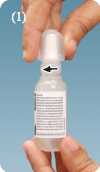
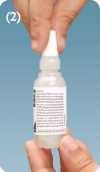
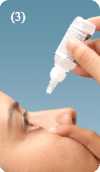
Snap off the dust cover by turning it clockwise to break the seal. Pull off the dust cover

Press a finger into the comer of eye, by the nose for 3-5 minutes
Unscrew the cap
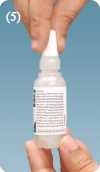
Screw the cap
Tilt head backwards. Dispense drops with gentle pressure. Do not touch dropper tip to the surface of the eye.
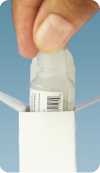
Replace the bottle in the outer carton after every use